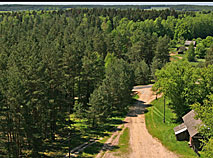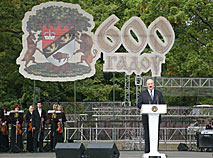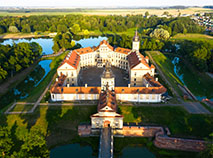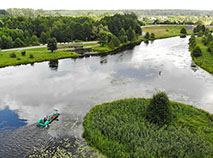UNESCO World Heritage Sites in Belarus

Nesvizh Palace
Belarus joined UNESCO in 1954. During many years, Belarus has been maintaining fruitful and dynamic relations with international organizations. Belarus’ program of UNESCO activities includes numerous interesting projects in the fields of education, science, information, communications, and, of course, culture.
In October 1988, Belarus joined the Convention on the Protection of the World Cultural and Natural Heritage adopted by UNESCO in 1972. Today 4 Belarus sites have been already included into the UNESCO World Heritage List.
In 1992, the Belovezhskaya Pushcha National Park (a natural heritage object), a unique European forest reserve protected since the 14th century, was the first one to become a UNESCO World Heritage Site.
In 2000, the Mir Castle Complex, which was built in the beginning of the 16th century, was added to the UNESCO World Heritage List. The successful blend of Gothic, Baroque and Renaissance architecture makes Mir Castle one of Europe’s most impressive castles.
In 2005, two more sites were inscribed into the UNESCO World Heritage List. They include the Architectural, Residential and Cultural Complex of the Radziwills in Nesvizh and the Struve Geodetic Arc points.
For centuries the Nesvizh Palace used to be the residence of the Radziwills, one of the richest dynasties in Europe. Today the National Historical and Cultural Museum-Reserve Nesvizh, a wonderful restored castle, is a landmark of Belarus.
The Struve Arc, a world famous geodetic construction, is a chain of 265 points in 10 countries: Norway, Sweden, Finland, Russia, Estonia, Latvia, Belarus, Ukraine and Moldova. According to the historical data, there were 34 geodesic points in Belarus, and only 20 survived. Five of them, with special plaques, have been inscribed into the UNESCO World Heritage List.
Sites nominated to join UNESCO World Heritage List
-
Augustow Canal (2004)
- Boris and Gleb’s (Kolozha) Church in Grodno (2004)
- Religious military objects in Belarus, Poland, (2004)
- Polesie wooden churches(2004)
Belarus will propose the architecture of Independence Avenue in Minsk for inclusion in the UNESCO World Heritage List as part of the transnational nomination file entitled Socialist Postwar Architecture in Central and Eastern Europe.
UNESCO World Intangible Cultural Heritage List, Belarus
Belarus and the Belarusians in the UNESCO Anniversaries List
-
200th anniversary of the birth of scientist, geologist Ignat Domeyko (2002)
-
200th anniversary of the birth of painter and composer Napoleon Orda (2007)
-
200th anniversary of the birth of poet, playwright and actor Vintsent Dunin-Martinkevich (2008)
-
600th anniversary of the reserve status of the Belovezhskaya Pushcha (2009)
-
200th anniversary of the birth of painter Ivan Khrutsky (2010)
-
1150th anniversary of the first mention of the town of Polotsk (2012) in chronicles
-
200th anniversary of the birth of scientist and diplomat Iosif Goshkevich (2014)
-
250th anniversary of the birth of politician, diplomat and composer Michal Kleofas Oginski (2015)
-
150th anniversary of the birth of Leon Bakst, artist, theater designer, decorator (2016)
-
500th anniversary of the Belarusian book printing (2017)
-
300th anniversary of the birth of Regina Salomea Rusiecka (1718-1763) (Belarus, with the support of Lithuania, Poland and Russian Federation) (2018)
-
200th anniversary of the birth of Stanisław Moniuszko, composer, conductor and teacher (1819-1872) (Poland, Lithuania and Belarus with the support of Latvia and Romania) (2019)
-
150th anniversary of the birth of Ferdynand Ruszczyc (1870-1936), painter, graphic artist, theater designer and educator (2020)
-
100th anniversary of the Belarusian State University (2021)
-
100th anniversary of the National Library of Belarus (2022)
UNESCO Awards
The UNESCO Five Continents Medal was bestowed upon:
-
Igor Luchenok (2016)
-
Valentin Yelizaryev (2016)
The UNESCO Victor Hugo Medal was presented to:
-
Tamara Nizhnikova (2015)
-
Gennady Ovsyannikov (2015)
-
Rostislav Yankovsky (2015)



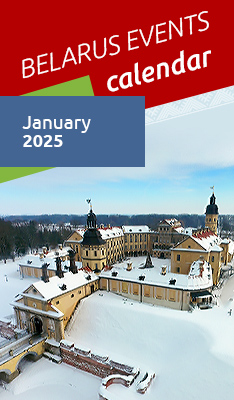




 print version
print version make home page
make home page add to bookmarks
add to bookmarks

